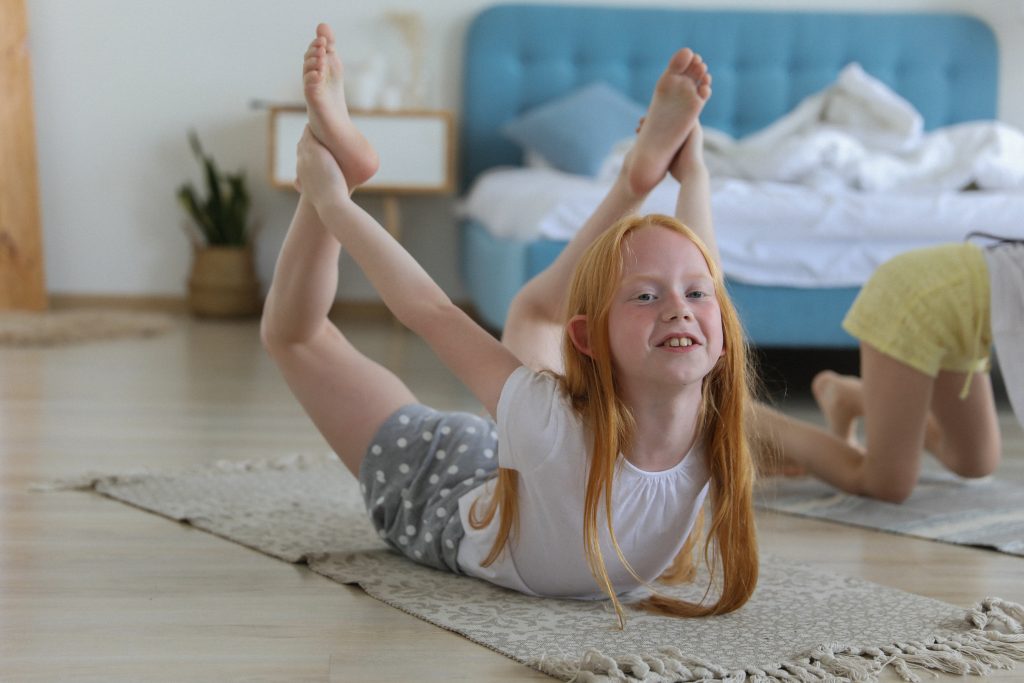This article has been reviewed by certified personal trainer Christopher Stadnik scientifically and practically.
It’s a common question among parents whether children need to work out, especially if they are already active throughout the day. Some parents are afraid that working out might be too much pressure on a child’s body. However, studies show that regular activity in children has long-term effects on their physical and mental health, and quality of life. The importance of adequate exercise training in children is emphasized by various credible health organizations and human kinetics specialists. Read this article to know what exercising means for children of different ages, how it affects them in the long run, and what should be avoided.
What kind of physical activities should kids do?

To begin with, let’s find out what training in children means. A standard physical training plan for kids should help them gain strength, endurance, and flexibility. This can be achieved by a wide variety of activities. Although this is not to say that they should go through a vigorous-intensity workout routine that includes lifting heavy weights and a sweaty session of a treadmill workout, going to the gym could benefit children.
There is also a vast range of activities and sports to keep kids active and healthy. Moderation and diversity in choosing the type, intensity, and frequency of exercise for children are crucial, and the activities should be entertaining as well. This can turn working out into a habitual activity in children throughout their life which has so many beneficial effects on a person’s health.
Training in children should include 3 types of activities:
1- Aerobic exercise
Aerobic means “with oxygen”. Aerobic exercise improves the cardiovascular condition and decreases the risk of heart disease. Examples of aerobic training in children are brisk walking, running, cycling, or swimming.
2- Muscle building exercise
Proper training in children should improve skeletal muscle building and strengthening. Resistance exercises such as push-ups, sit-ups and planks, gymnastics, and weight training are just some of the exercises that can increase exercise tolerance and contribute a lot to skeletal muscle building in children. These activities should be done 3 sessions per week, for 60 minutes.
3- Bone strengthening exercise
Sports that involve jumping or quick changes in direction have beneficial effects on bone health and strength. Examples of these exercises are running and jumping rope. (source)
What is proper exercise training for children of different ages?
Children and young people require aerobic exercise that helps improve their cardiovascular conditioning and exercises that strengthen their muscles and bones. The key here is controlling the intensity and adding variety during the week to cover a wide range of goals, from developing movement skills to improving their muscular and skeletal system.
Children of different ages require different physical activity levels. However, each child might have a different exercise capacity than the other. The important thing is for all kids to have an active lifestyle that matches their physical conditions and exercise tolerance levels. Here are the proper physical activity levels for kids of different ages.
Babies and toddlers
For babies who cannot crawl yet, exercise recommendations include simple movements such as pushing, pulling, and grasping to discover their body and begin to learn how to use it. You can also help them move their head and limbs as part of their daily exercise. After they start to crawl, you may add more moves to this routine. Toddlers, however, have a lot more options for aerobic exercise since they can move around more freely. The best types of exercise for toddlers are walking, running, skipping, hopping, and dancing. kids have very delicate bodies at this age, so, exercises should be light and safe. Be careful not to tire them out or put too much mental pressure on them.
Ages 3 to 5
CDC exercise recommendations for children of ages 3 to 5 years is to physically active throughout the day. Preschool children can enjoy various activities. Some parents get frustrated with their kids’ high exercise capacity. They should know that these activities are normal and in fact necessary for kids to grow and develop a healthy body. Exercising at this age should be all about fun and play and not about competition or tough goals.
Ages 6 and above
Exercise recommendations by CDC say that children of ages 6 to 17 should get at least 1 hour of moderate- to vigorous-intensity activity. Most of this time should include aerobic exercises such as walking, running, playground games, dancing, and swimming. They can also take part in team sports like soccer and basketball 2 or 3 times per week to develop their personal and social skills. Moreover, children of these ages need muscle-building and bone-strengthening exercises, at least 3 times per week, such as resistance exercises and weight training using their own weight, exercise bands, light handheld weights, and weight machines.
Children go through a huge amount of change in their bodies during the ages of 6 to 17, so, let’s break this period into smaller segments and go over the best exercise activities for each age, according to Healthline.
Ages 6 to 8
At this point, kids should have developed enough skills to be able to start playing sports such as gymnastics, soccer, and basketball. Training in children of these ages should include various activities to help different growth plates in the kids’ bodies. Focusing on one sport increases the risk of injuries.
Ages 9 to 11
This is the age when children most develop their hand-eye coordination ability, hence being able to hit a ball with a tennis racket or baseball bat. They should be supervised to take safety measures such as hydrating, warming up, cooling down, and keeping their physical activity levels to standard.
Ages 12 to 14
Most kids reach puberty around this age and experience a growth spurt. Some become more interested in adopting a more professional attitude toward a specific sport while others lose their interest in organized sports and prefer doing exercises that contribute to physical fitness. However, kids’ bodies are still not ready for heavy weight training at this age. One-rep max weightlifting should be avoided altogether before puberty. It’s recommended that kids this age do body-weight exercises to improve strength, flexibility, endurance, and coordination without putting their bones and joints through too much pressure.
Ages 15 to 17
Kids who have gone through puberty have the exercise capacity to start weight training. However, it’s essential to go about it slowly and learn the right techniques to avoid any muscle or bone damage. Kids this age can also participate in endurance exercises such as triathlons and marathons.
How does exercising help my kid have a healthier body and mind?

Exercise training in children should inspire fun and provide them with opportunities to socialize. This is because children are at a sensitive stage regarding their mental and physical development and should be given enough chance to make the most of this period. There are loads of evidence that exercise plays a crucial role in reducing the risk of chronic diseases if a person adopts a regular exercise routine from a young age.
Moreover, research indicates that children who choose a sedentary lifestyle are more likely to become inactive as adults and develop life-threatening conditions and chronic diseases. Improving physical fitness and health are the two most apparent results of regular exercise, but it can also help children learn necessary social skills and boost their self-esteem.
Here are some effects of exercise training on kids’ health:
Helps prevent cardiovascular diseases
Exercising strengthens the heart and blood vessels and reduces cholesterol and harmful fats in the blood. That is why an active lifestyle from a young age helps avoid heart diseases, heart attacks, and strokes.
Contributes to lung health
Exercising contributes to pulmonary health by increasing lung capacity and peak oxygen consumption. Healthy lungs can draw more oxygen and expel carbon dioxide better, which has beneficial effects on the body.
Maintains cardiopulmonary fitness
Exercising improves cardiopulmonary fitness, meaning it elevates the capacity of the circulatory and respiratory systems to bring oxygen to muscles to produce energy.
Helps prevent diabetes
Exercising makes muscles take sugar from the bloodstream to produce energy. This reduces blood sugar levels and helps lower the risk of diabetes.
Helps prevent high blood pressure
Regular exercising throughout life helps maintain healthy blood pressure levels by reducing stress.
Helps prevents osteoporosis
Children and adolescents who have high physical activity levels develop strong bones that are less prone to losing bone density and strength.
Increases lean body mass
Building lean body mass is difficult and needs years of healthy lifestyle and exercise. Proper physical training in children can dedicate to reaching a healthy percentage of fat and lean muscle.
Helps prevent cancer
Inactivity can increase the risk of cancer, especially in the colon, lungs, and endometrium.
Contributes to mental health
Exercising releases beta-endorphin and serotonin which helps regulate mood, boost energy, and strengthen nerve cells. it reduces the risk of depression and neurological disorders like Parkinson’s disease. Getting a good night’s sleep and handling stress are among the advantages of an active lifestyle for children and adults alike. Physical fitness boosts self-confidence and allows kids to feel better about themselves.
Helps academic success
Previous studies show that the impact of regular exercise on academic performance is considerable. Exercising increases the flow of oxygen to the brain and improves concentration, memory, and learning and thinking abilities.
When can exercise training be harmful to my child?
Now let’s examine the situations that might be harmful or negatively affect children. Unless children go through unsupervised exercise training using poor technique, it’s unlikely they encounter any serious problems. This, of course, means constant and close supervision of an adult who possesses the appropriate knowledge and expertise of human kinetics to guide them through the process with care and compassion. Safety should always be the priority in choosing the type of workout.
In addition, you should steer clear of creating an environment that invites rivalry and judgment, as the ultimate goal of any exercise in children is being healthy and not training medal winners. It is also necessary to take the limitations and exercise capacity of each child into account. While one child may have a better aerobic performance, another might have better anaerobic capacity. You should not force a kid to do something that is beyond their exercise tolerance. This would, in turn, discourage them from any exercise training at all. Therefore, determining the right physical activity levels for children of any age takes precedence over any other matter.
Physical training beyond children’s exercise tolerance can lead to injuries and mental health problems and discourage kids from working out altogether. Here are 3 health conditions that are caused by too much exercise in children:
Overuse injuries
Nowadays, one has to start professional sports very early to become a world-class athlete. This can put a lot of pressure on a young body (let alone mind) and cause injuries that can even be permanent. Previous studies by The American Academy of Pediatrics recommend that kids who train professionally get at least 1 day off a week and preferably not have more than 5 training sessions per week. They should also get 2-3 months off a year to heal injuries with rest and physical therapy and prepare mentally for the next season.
Burn-outs
Exercising is meant to tune and regulate body, mind, and lifestyle. Once moderation is lost, your child can feel sick of a particular sport or even exercise altogether. It is important to teach kids the significance of balance and moderation in life to maintain a wholesome lifestyle and a healthy body and mind.
Anorexia Athletica
Anorexia Athletica, also known as compulsive exercising, is a mental health disorder in which exercising becomes the main concern for a child. It happens in children who feel too much external pressure to succeed in sports activities, lose weight or win competitions. In this condition, the kid does not enjoy exercising anymore but feels a compulsion to do it anyway.
Anabolic steroid abuse
Feeling too much mental pressure is tough on kids. Children and young adults who become obsessed with athletic success or body shape may turn to anabolic steroids as an easy fix to excel in sports activities or build bigger muscles. Anabolic steroids can cause a vast range of health problems in the youth and lead to serious diseases. Kids and adolescents must be informed and warned about the consequence of using these drugs. Moreover, they should be given the right mindset to maintain healthy habits and protect their mental health.
The final verdict

To sum up, exercise training in children helps them keep healthy physical activity levels throughout life. If this positive habit is encouraged among children, they can avoid many health issues in the future and lower the risk of them choosing the wrong path in life. Furthermore, exercising can give them the necessary skills they will require to function well as adults. Hence, the advantages of exercising have beneficial effects that will keep them healthy and happy during childhood and serve them well through adulthood.
